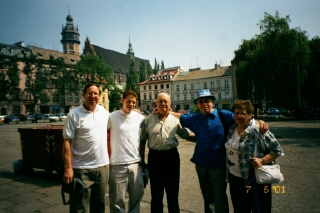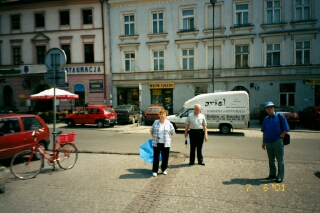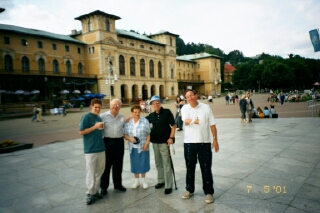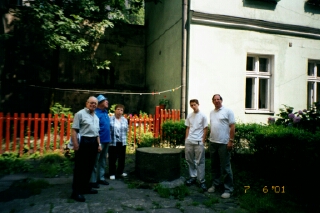The Halpern Family in Krakow
Addendum Note to Camp
Columbia Campers and Counselors
![]()
The Halpern Family in Krakow
A Family Survives, A Family Thrives
A plume of singing voices, liquid sound, flowed out of the window and into the street on a hot Friday night in Kaszmirez Krakow, Poland. It was July 2001. One hundred and fifty people, strangers to each other, did not notice the stuffy air as they sang along with a Chabad leader, who was in a trance of ecstasy. In Kaszmirez.
Happy Kaszmirez. Happy in early 1941. Happy on a Friday night in 2001. Jacob and Aron and three generations of Halperns, breathing and singing zmirot in Hebrew, just like any other Friday night. Except that we were in Kaszmirez.
Kaszmirez, the neighborhood where Jacob and Aron grew up. Kaszmirez, the neighborhood where Jacob and Aron lived and learned, played and laughed, and learned some more. Kaszmirez, the neighborhood where Jacob and Aronís mother had a store on Wolnica square. Kaszmirez, the neighborhood where Jews lived, thrived and prospered since the 1300ís. Kaszmirez, the neighborhood which sustained the best that Jewish culture and family life had to offer for centuries.
Kaszmirez, the neighborhood where Jacob and Aron enjoyed Jewish family life, with their parents, Mayer and Sara. For the last time. Before they went to the Ghetto. Before they were separated. Before they went to concentration camps. Before their parents were murdered. Before they had numbers on their arms. Before the Germans and Poles tried to reduce them to subhumanity. Before all that. Before Jacob and Aron, children, reluctantly were put to the test of indescribable loss. Before they were put to the test survival. Before they were put to the test of greatness.
This is the story of the Halpern family in Kaszmirez. What was lost. What survived. What thrived.
This is the story of returning after 60 years for the first time to breathe and sing zmirot in Hebrew in Kaszmirez. Just in case their parents could see Jacob and Aron from beyond and say "weíre very proud of you." Just in case their parents could see them from beyond and say "you kept the Halpern family name alive for us." Just in case their parents could see them and say "you did a great job in keeping the Jewish heritage alive and dedicating so much to the education of thousands of Jews in America, Israel and all of the world." Do you think Jacobís and Aronís parents were watching on this Friday night in Kaszmirez? I am sure that Mayer and Sara could see everything very clearly.
![]()
Halpern Family History & Life
in Krakow
Mayer Halpern and Sara Frankel were married in Kaszmirez in 1923 and lived at
16 Meiselas Street in Kasmzirez (the building stood in
2001 no differently except for a paint job). Mayer was a learned Talmudic
scholar from countless generations of prolific rabbis who wrote commentaries on
the Bible and had great followings. The Halpern family had Yihus. Sara was a
mother and businesswoman. Sara skillfully managed a gift and crystal shop in
Wolnica square (see Pictures 1 and 2; in 2001 a violin maker has a shop there)
opposite the city hall and an open market in the square twice a week. Wolnica
Square was quite a place. There is a plaque on the city hall building (now a
museum) engraved with a scene showing King Kasimir welcoming the Jews to this
neighborhood outside of Krakow in the 1300ís (see Picture 3). You
see, there once was actually a Pole who welcomed the Jews. So the Jewish quarter
was named after Kasimir. Kaszmirez. The home of generations of Halperns.
Picture 1: Wolnica Square (right to left: Gilda Halpern, Jacob Halpern, Aron Halpern, Oz Halpern, Mayer Halpern):

Picture 2: Jacob and Aron return to the family store in Wolnica Square after 60 years (the two windows to the left of the white car):

Picture 3: Plaque of King Kasimir welcoming the Jews in the 1300's:

In the summer, the Halpern family would move to Krynitza, a bustling resort town near the Slovakian border known then and today for its therapeutic water (see Picture 4). You can still go to Krynitza to get the famed Krynichanka water. Just bring a cup, or preferably a small porcelain vase with a straw, and a zloty or two. In 1940, you could have bought the porcelain vessel from Sara Halpernís gift shop in Krynitza. If you came to either store in 1940 and it was between the hours of one oíclock and four oíclock, you would find Mayer studying Talmud. Actually, you probably would have Mayer studying Talmud anytime anywhere.
Picture 4: Drinking "Therapeutic Water" in Krynitza:

Jacob arrived to the family, or should I say community, on September 11, 1924, born right there in the house on Meiselas Street. Aron was born in 1927. The grandfather lived on the first floor. Mayer and Sara lived on the third floor with their new baby, Jacob. The balcony on the fourth floor was used as a Succah. There was a Beit Midrash just next door (in 2001 it is a youth center), how convenient. The Shaharit morning prayers were of the express version, changing out every 15 minutes, so people could get to work. Jacob and Aron first went to Heder and then graduated to elementary school (in 2001 the building houses a health clinic). In order to make the great move from Heder to elementary school, you had to give a lecture called a Dvar Torah, usually at age 3. The community would jam into the room and the three year old would be put on a table. Then the adults would remove their jewelry gold watches and other valuable and decorate the child. The weight while giving the Dvar Torah was heavy. And then there was the weight of the jewelry.
You didnít have to study all of the time. You could go to the meat market (circular building still a meat market in 2001) and pump water (Picture 5). You could go down to the Vistula River and watch barges go by. However, you were not allowed to main market downtown (Rynek Glowny). Jews were not welcome there.
Jewish life thrived in Kaszmirez. Commerce thrived in Kaszmirez. There was a strong sense of community in Kaszmirez. Real communities are rarely found in the world today, and when there are such real communities they are usually in areas in which a lot of people live in close quarters. Suburban American neighborhoods consider themselves communities, but they arenít communities in the sense that an ethnic quarter of a large American city may have been in the early 20th century.
Picture 5: Water well which thousands of Jews used to get "resting water" (Maim Omdim) for Matzah before Passover:

Throughout the centuries, where ever Jewish life thrived, so did anti-semitism. The Corpus Christi church (Body of God) was right in the center of Kaszmirez (and still is; Picture 1). There was a high wall (still is) around the church. Jacob and Aron had to walk by the church to go from their house on Meiselas Street to Wolnica Square (Picture 1 shows the church in the background and the store just to the right of the restaurant on the corner). The Catholic children inside the church would use periscopes to look over the wall. Jewish children could easily be recognized by their attire, dressed in black and white and had long curly sideburns (Payot/Payos). When a Jewish boy was spotted on the street through the periscope, stones would be flung over the wall and the Jewish children were injured. Mayer Halpern instructed Jacob and Aron to walk as close as possible to the church wall because the periscopes couldnít see that close and even if they could the stone throwers would risk throwing a stone which would come right back down on them. When Jacob and Aron would arrive at the store, Sara would ask, "how did you get the white powder on the left sleeve of your black jacket?" Jacob and Aron really went as close as possible to the crumbling wall.
Perspectives on Poland in 1941
and 2001
As the whole, Poland was anti-semitic in 1941. When Crystalnacht happened in Germany,
there were actually German citizens that protested. Very few large concentration
camps were built in Germany. They were built in Poland not only because of
proximity logistics but also because the average Pole was much more amenable
killing Jews than the average German. In the 1990ís, Holocaust studies are required
courses in German public schools and most German feel remorse about the
Holocaust. Holocaust studies are still not part of the
Polish school curriculum. In the 1940ís, there was no significant Polish
resistance to building concentration camps.
Krakovian commerce did very well
until the Jews were removed in the 1940ís. There were 70,000 Jews in the
Podgorze ghetto (still there in 2001) who were moved from Kaszmirez, just over the Vistula
river. This is depicted with great accuracy in Schindler's List. The Halpern family apartment
in the ghetto was on
15 Jozefinska St. in Podgorze. Of these 70,000 Jews, 1000 survived the Holocaust, including Jacob and Aron.
After
WWII, the Jews were not in Krakow. Communism came to Poland. Commerce and the
economy were in poor shape. Some say there is a correlation. In 1989, Communism was chased away from Poland. In
2001, Poland is still poor and canít get into the European Union, because it
canít meet the economic criteria. Poland has had 12 years (1989-2001) to get
their economic act together and canít seem to move forward. "It has only
been 12 years" say the Poles. It took a lot less than 12 years for 90% of
the Jews after concentration camp to resurrect their family life and economic
life from the depths of inhumanity. "Only 12 years" is not an excuse.
![]()
Addendum
Written For the Camp Columbia Reunion - May 2004
Camp Columbia Camper and
Counselor
YOU ARE THE MULTIPLYING
LINK!
If you ever wonder how much difference one person could make, and I mean YOU,
consider this. Yaakov Halpern survived the Holocaust by some miracle. Gilda
Halpern grew up very poor with no father in the slums of Newark, New Jersey.
Based on what life dealt them, these two people could have easily decided
"not to get involved" or take initiatives to build a Jewish
environment for others and they would have had a lot of justified
reasons/excuses. Instead, Yaakov and Gilda chose to be a link between
hundreds of generations of Jews in the past and generations of Jews which will
hopefully thrive in the future. If the only impact Yaakov and Gilda would have
had was, for example, to contribute to Paul Jeser's love of Judaism, then dayenu,
because Paul is now the catalyst for thousands of Jews to be dedicated to their
Jewish heritage. But since you were a camper or counselor at Camp Columbia, you
probably know that Yaakov and Gilda contributed to the Jewish culture and
motivation of a few others. So we must carefully consider the multiplying effect
of even single opportunities to explain our Jewish heritage and culture to a
young person on the verge of assimilation or on the verge of being the next
leader. Not sure? Consider the multiplying effect of the childhood bedtime
conversations between Mel Gibson and his father.
Obviously, David and I are thankful that Yaakov and Gilda got together (or we
wouldn't have been born). Beyond that, Yaakov and Gilda have always been
internally driven by some unknown force to establish/lead Jewish organizations
such as Mid Island Hebrew Day School (Plainview, NY), Camp Columbia, Eliyahu
Academy (Louisville, KY), Beit Shraga (Albany, NY), the Machon Greenberg
Teachers Institute (Jerusalem), Jewish National Fund Education Program
(Jerusalem) and other Jewish educational programs. This is not a resume, this is
simply a collection of data which hints at the impact individuals can have on
the community. In some cases, on thousands of people in several communities
each. In some of these cases, they did this without financial resources and
without the benefit of pre-existing organizations.
We are having a Camp reunion in May 2004. This is a reunion of people who are
bound by a common experience in Camp Columbia and who care enough about it 40 or
so years later to get together. Some of us are less active in the Jewish
community (like me currently) and some of us are absolute leaders (like Paul
Jeser, Lonny Benamy, Doni Schoenholt..., started by influencing dozens of
campers at a time...now influencing thousands of lives at a time each). But no
matter how involved we are, we really do have an impact.
And the huge impact can result from unbelievably minor events. For example, do
you remember the night in the 1960's when Yaakov came to your house (after a
long day as principal of Jamaica Jewish Center and instead of being home with
Gilda, David and I) to make the presentation to your parents about registering
for Camp Columbia for the first time? Your parents obviously said "sure,
c'mon over." What if your parents made up some excuse (hairdresser,
meeting, etc. like we would do today) and Yaakov did not come that night and
couldn't return to pitch the Camp? Maybe it wouldn't have made an impact in your
life. Then again, maybe it would have. Maybe it wouldn't have made an impact on
the 6000 year history of the Jewish people through you. But then again maybe it
would have. Do you think that someone else's parents did make an excuse on that
night in the 1960's and would have been a great camper/counselor/future Jewish
leader? What a shame we didn't get to bunk with that kid.
On a personal note, we moved to Israel in the summer of 1969 instead of
opening the Camp for another summer. I finished up high school in Jerusalem (I
was left back in 11th grade), fought on the Sinai front in the Yom Kippur War
and married a good Israeli girl. But since I moved back to the US in 1983, I
haven't been extremely active in the Jewish community. I am sure I missed
opportunities in the past year to influence a member of our dwindling community.
Was I a multiplying link this year for the Jewish community or did I make up
some excuse and watched TV instead? If I didn't do the job, will someone make up
for that? Would that someone be you?
![]()
Consider taking a trip to Krakow. It might be very important. If you can't go to Krakow, maybe you can make an impact by volunteering to tell your local Hebrew school kids of what it was like growing up Jewish and going to Camp Columbia. It just may inspire some Jewish kid.
Work in progress: A day earlier, the first non-obnoxious Chabad person I ever met pulled us off the street in Szeroka Square, outside the Remuh synagogue to put on Tefillin and asked us to join him in the Friday night celebration. Expecting a request for charity, we showed up anyway and soon learned that we were there to celebrate the fact that we were simply breathing. But you know, breathing is no simple matter. It should be celebrated. So there we were. Jacob and Aron and three generations of Halperns, breathing and singing zmirot in Hebrew, just like any other Friday night. Except that we were in Kaszmirez.